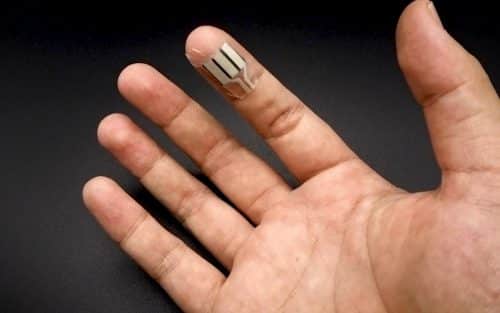This sweat-fueled wearable device generates power even while the wearer is asleep or sitting still.
Engineers at the University of California San Diego have developed a flexible strip that can generate small amounts of electric currents from the sweat and pressure of a person’s finger. This wearable device is thin and can be worn on a fingertip.

This type of device is the first of its kind, said co-first author Lu Yin, a nanoengineering PhD student at the UC San Diego Jacobs School of Engineering. “Unlike other sweat-powered wearables, this one requires no exercise, no physical input from the wearer in order to be useful. This work is a step forward to making wearables more practical, convenient and accessible for the everyday person.”
The results of this new study are published in Joule.
According to the engineers, the wearable device also generates extra power from light finger presses. This means it will be possible to generate electricity from activities such as typing, texting, playing the piano or tapping in Morse code can also become sources of energy. How cool would that be!
“We envision that this can be used in any daily activity involving touch, things that a person would normally do anyway while at work, at home, while watching TV or eating,” said Joseph Wang, a professor of nanoengineering at the UC San Diego Jacobs School of Engineering and the study’s senior author. “The goal is that this wearable will naturally work for you and you don’t even have to think about it.”
While we all believe that we sweat more in other parts of the body, the true fact is that the fingertips are one of the sweatiest spots on the body with each one packed with over a thousand sweat glands. “The reason we feel sweatier on other parts of the body is that those spots are not well ventilated,” said Yin. “By contrast, the fingertips are always exposed to air, so the sweat evaporates as it comes out. So rather than letting it evaporate, we use our device to collect this sweat, and it can generate a significant amount of energy.”
This technology, according to Wang, is unique because it could serve as a power source anytime, anywhere.
How it works
The thin wearable device can be wrapped around the fingertip like a Band-Aid. The padding of carbon foam electrodes absorbs sweat and converts it into electrical energy. The electrodes are equipped with enzymes that trigger chemical reactions between lactate and oxygen molecules in sweat to generate electricity. Underneath the electrodes is a chip made of a piezoelectric material, which generates additional electrical energy when pressed.
A small capacitor stores the electrical energy as and when the wearer sweats or presses on the strip and is discharged to other devices when needed.
The researchers had a subject wear the device on one fingertip while doing sedentary activities. From 10 hours of sleep, the device collected almost 400 millijoules of energy — this is enough to power an electronic wristwatch for 24 hours. From one hour of casual typing and clicking on a mouse, the device collected almost 30 millijoules.
And this is just from one fingertip. Strapping devices on the rest of the fingertips would generate 10 times more energy, the researchers said.
“By using the sweat on the fingertip — which flows out naturally regardless of where you are or what you’re doing — this technology provides a net gain in energy with no effort from the user. This is what we call a maximum energy return on investment,” said Wang.
“Compare this to a device that harvests energy as you exercise,” explained Yin. “When you are running, you are investing hundreds of joules of energy only for the device to generate millijoules of energy. In that case, your energy return on investment is very low. But with this device, your return is very high. When you are sleeping, you are putting in no work. Even with a single finger press, you are only investing about half a millijoule.”
“We want to show that this is not just another cool thing that can generate a small amount of energy and then that’s it — we can actually use the energy to power useful electronics such as sensors and displays,” said Yin.






